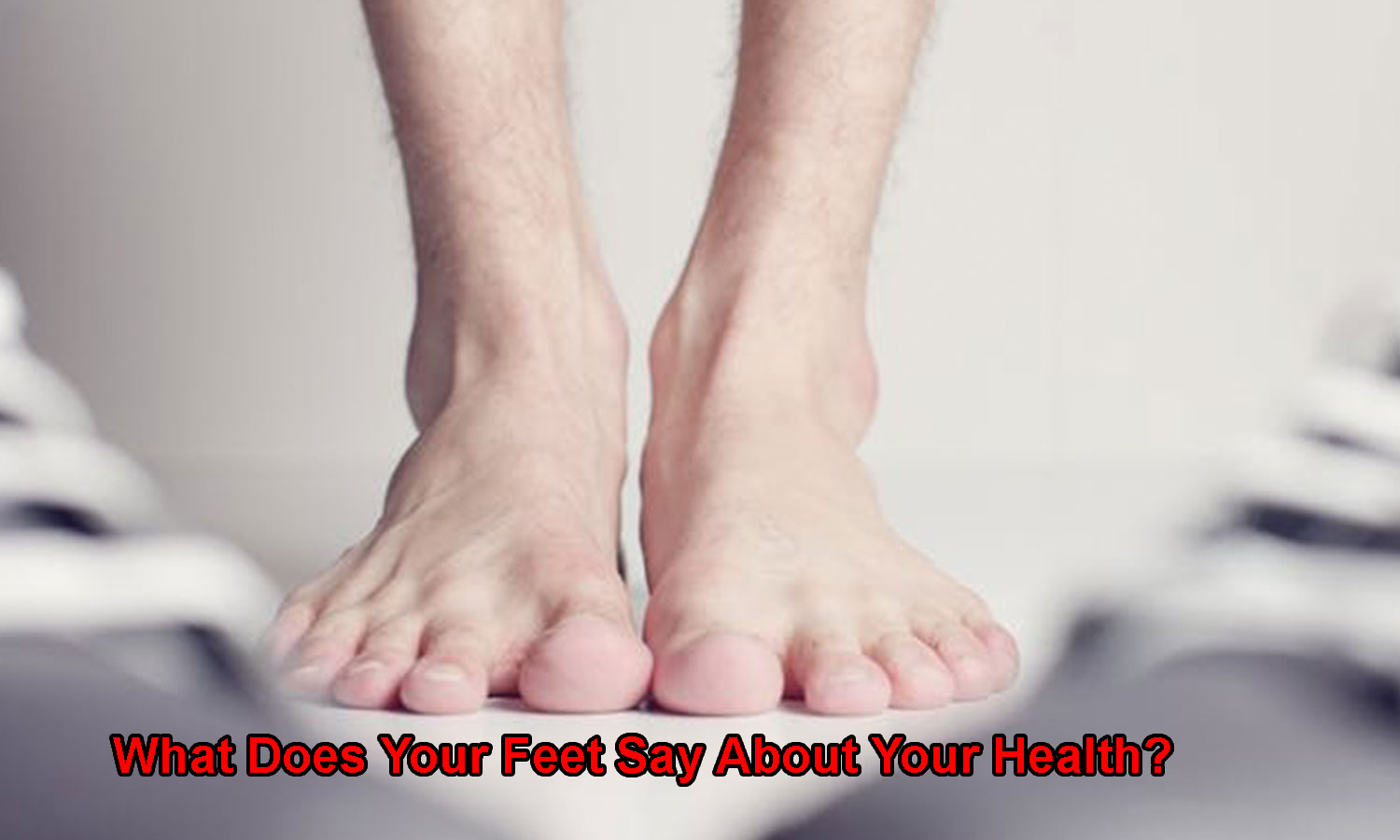What Does Your Feet Say About Your Health?
Your feet can provide some information about your health and well-being, because any infection or discomfort that bothers your body tends to affect your foot health and display the earliest symptoms. While foot diseases are mostly caused by infections that damage your circulation, diabetes is a common cause of these problems.
For more information, take a look at the foot diseases listed below:
1. Heel pain
Pain in your heels is often caused by plantar fasciitis, a very common form of inflammation where a long ligament is attached to the bone of your heel. The pain gets worse when you wake up in the morning and try to put pressure on your feet.
There are several other causes of heel pain, such as a hard and over-exhausting workout, poorly worn heels, tendonitis and arthritis. Other very rare causes include the presence of a tumor, a protrusion of the heel bone, bone infection, or bone fracture.
2. Claw Foot
Claw toes are a common foot problem caused by diseases that damage your nerves such as alcoholism, neurological disorders and diabetes. However, it can also be caused by tight shoes that damage your feet and cause your toes to bend.
Claw toes are basically a type of foot deformation that causes your toes to bend upward and move out of your toe ball and eventually take a downward position from your middle joint, which takes the form of a paw. This deformation can be improved by stretching and exercising with specific types of shoes. However, in some cases, doctors are also forced to perform surgery.
3. Big Toe Diseases
If you experience swelling, redness, and sudden slicing pain in the joints of your thumb, there may be several causes. For example, gout is the most common cause of big toe pain, and osteoarthritis is another cause of sudden swelling and pain.
There is another condition known as halux rigidus that is caused by arthritis caused by bone protrusion and causes stiffness in the joints of your big toe. Another common cause of this disorder among athletes, particularly those playing on hard surfaces, is the grass fingers and damage to ligaments around the joint.
4. Being forced to drag feet
Slight foot drag, changes in the way you walk, or a wider walk may be the earliest symptoms of the disease. Research reveals that approximately 30% of these cases are caused by diabetes. However, the primary reason is the absence of sensation and normality in your feet, and this is due to peripheral nerve damage, which is very common among diabetic patients. However, in some cases, vitamin deficiency may never be harmed by excessive liquor consumption or infection.
Problems with your brain muscles, brain organs and spinal cord can also cause foot rubbing. In some other foot drag cases, nerve damage is often not responsible.
5. Feet start to burn
Diabetic patients with peripheral nerve damage often get a sharp, burning sensation from their feet. However, this feeling is also mainly caused by the absence of blood circulation in your legs and feet, vitamin B deficiency, chronic kidney infections, hypothyroidism, and even other health conditions such as athlete’s foot, such as peripheral arterial disease.
6. Yellowish transforming toenails
Your toenails are the best indicators of your health and you should not delay in interpreting their symptoms. If your nails begin to turn yellow, the possibility is caused by a serious fungal infection.
Dark yellow toenails are also a symptom of serious health problems, such as lung infections, rheumatoid arthritis, psoriasis and lymphedema, which are basically a swelling in your lymphatic system.
7. Foot Pain
If you walk around in high-heeled shoes all day long, your feet start to ache at the end of the day.
Research shows that 8 out of 10 women admit that their feet have been hurt and knowingly put themselves into such a misery. However, if you didn’t have 6 ”high-heeled shoes that caused pain and luck, the stress fracture caused a small crack in the bone of your foot.
Other causes can be a tiring intensive training session, especially if you are playing too many jogging sports and other high-impact sports like basketball and football. Osteoporosis also weakens your bone and puts you at risk of developing foot pain.
8. Clubbed Toes
When your toes are collected, the shape of your toes and toes begins to change. Nails tend to be curved from the lower region as they roll from above. Research has shown that lung infections are the most common cause of club toes, but may also be caused by liver damage, heart and digestive disorders.
In some cases, there is no underlying cause and the club is due to genetic factors. Therefore, if your family has club toes, you should consult a doctor and take effective preventive measures.
9. Wounds that refuse budding
If you experience foot wounds that refuse healing, consider them as a clear indicator of diabetes.
Diabetes causes a lack of sensation in your feet, while delaying the normal healing process of the wound, as well as damaging the blood circulation process in your body. Therefore, if you have diabetes, even the smallest wound or cut can become a serious pain in the neck. Such wounds also begin to attract bacteria and infections.
If you are a diabetic patient, you should wash and dry your feet daily and examine closely for wounds, cuts or blisters. However, these wounds may also be caused by disorders such as peripheral arterial disease that disrupt the blood circulation process.
10. Foot Spasms
Fatigue, hard work and muscle pains can cause sharp and slicing pain in your feet and may take several minutes. This sudden spasm may also result from a muscle cramp or spasm, as well as a lack of proper blood circulation, a possible imbalance of Vitamin D, potassium, calcium and magnesium in your body, and finally dehydration.
While pregnant women experience foot spasms due to the rapidly changing hormone levels in the body, research reveals that thyroid diseases also cause foot spasms.
If it’s about muscle fatigue, there are various exercises and stretching tips to help you get rid of these spam. However, if the pain is severe and persistent, see a doctor immediately.
11. Spoon-shaped Toenails
Some injuries can cause your nails to get drunk like a spoon, and iron deficiency may also occur. In other cases, continuous exposure to petroleum-containing solvents can cause your toenails to take this strange shape.
12. Nails begin to pit
If you detect that the surface of your nails has begun to pit or if you feel that a hole has formed on the surface of your nail, the chances are that the growth of the nail is impaired and the nail plate is damaged. This disease is very common in psoriasis cases.
13. Extreme Itching
You may experience excessive itching and scaly spots on your skin due to a common fungal infection known as the athlete’s foot. It may also be caused by dermatitis, a reaction caused by some skin care products and chemicals. Scaly dry patches and redness cause severe itching.
However, if itchy skin has an acne-like structure and looks too thick, the possibility is due to psoriasis, a condition that indicates problems with your immune system. You can get rid of the symptoms with antifungal and medicated creams sold without prescription.
14. Toes that turn white, blue and red
If your toes begin to turn white, then if you assume a light blue color, and then there is redness, your chance is to have Raynaud’s disease only to eventually return to the natural shadow. It is caused by vasospasms that cause your arteries to contract.
Vasospasms can be caused by a variety of causes, such as anxiety, stress, and weather changes, so they often do not cause serious health concerns. However, medical research has also linked Raynaud’s disease to Sjogren’s disease, thyroid diseases and rheumatoid arthritis.
15. The feet swell
Usually you have had a very long flight when you are pregnant or have been standing for too long, your feet swelling for a while. However, if the swelling is not temporary and refuses to go, it is indicative of a serious health condition.
This swelling may be caused by blood clots, insufficient thyroid, discomfort in your lymphatic system, lack of proper blood circulation, and kidney disorders. If swelling of your feet lasts more than a day, consult a doctor immediately!
16. Little finger pains
When your little finger starts to ache, you experience a burning sensation that causes great pain in the upper part of your foot and then spreads to your toes.
You often feel as if you are walking on hard and slippery marble. You’ve probably developed Morton’s Neuroma, a condition in which the tissues around your nerve are between your third and fourth ones, causing thickening and pain.
This disease is more common in women than in men. Pain in your little finger may also be caused by an injury or by applying great pressure on your toes.
17. The appearance of white areas on your nails
White spots on the nails may be caused by a possible injury to the nail or elsewhere in your body. If a part of your nail is chipped or your entire nail is separated from the nail bed, it starts to become white. And this can be due to an injury, psoriasis or nail infection. However, if the nail is not broken or separated and is still white, this may be a symptom of serious diseases such as renal failure, liver infections and congestive heart failure.
It is best to consult your doctor and have the relevant tests foreseen.
18. Do you feel cold feet?
If your feet tend to get cold all the time, there are several reasons why. For example, a circulatory disorder can cause blood flow to your body to deteriorate and keep your feet cold. These circulatory problems are closely associated with diseases such as high blood pressure, severe heart disease and excessive smoking.
If your diabetic condition is unchecked, it can cause serious nerve damage, often causing cold feet. Some other causes include anemia and hypothyroidism, but only your doctor can rule out the real culprit and give you a proper diagnosis for cold feet.
Now that you are aware of all possible foot disorders and their causes, it will be much easier to heal them and make a correct diagnosis. In most cases, keep in mind that these foot diseases are only signs and indicators that indicate the presence of serious and harmful diseases in your body. Therefore, it is very important to consult your doctor without unnecessary delays.














Comments